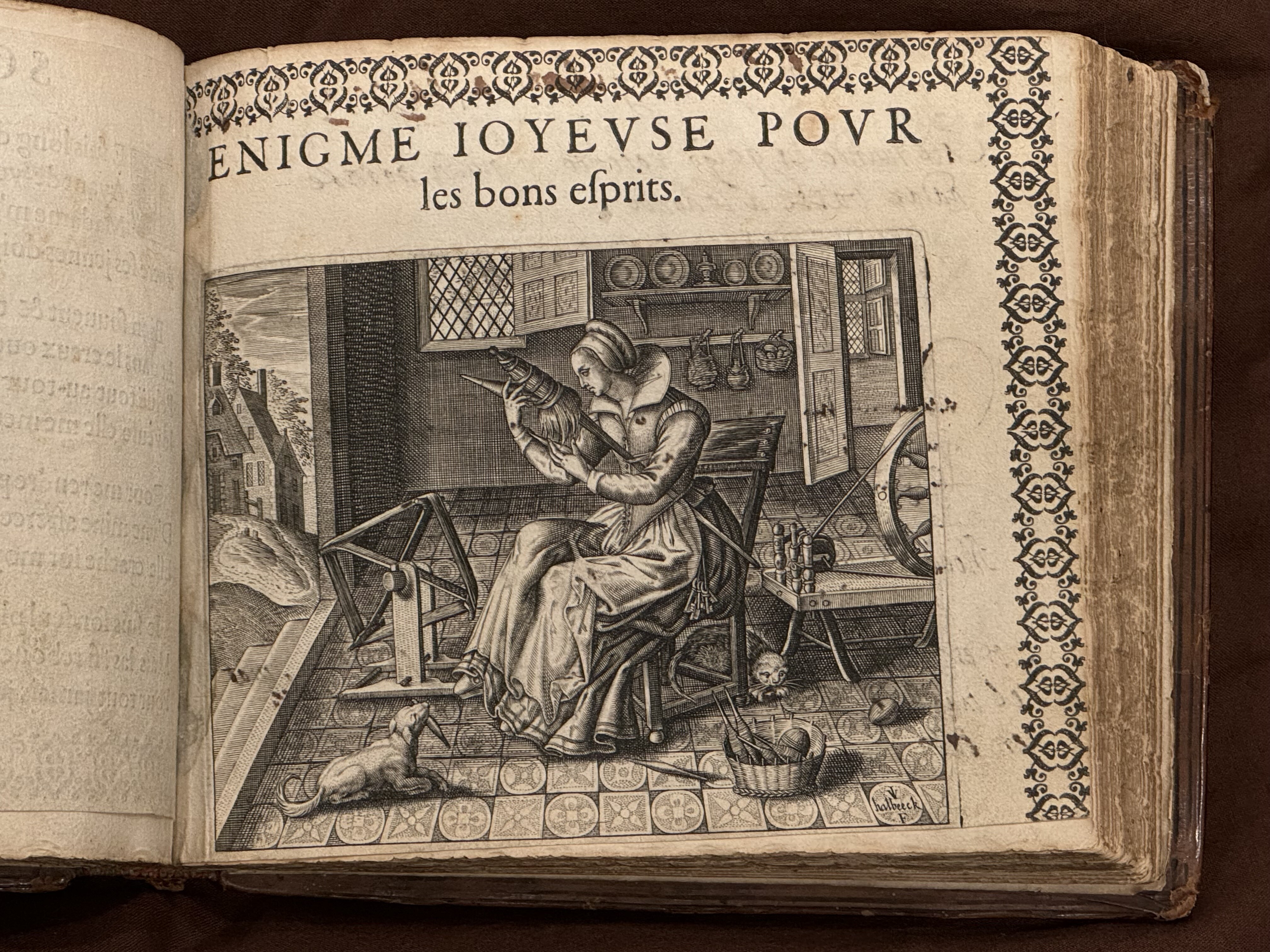By Christopher Lu
Some images seem to lure their viewers’ minds into the gutter, and this seventeenth- century engraving is one of them. It is housed in a manuscript album easily cradled between two hands that belongs to the genre of friendship albums (alba amicorum): personal scrapbooks of sorts meant to be passed among friends to leave their marks. It belonged to a woman by the name of Susanne who came from the French-speaking Dutch duchy of Limburg (now in Belgium) and was married or betrothed in 1597, as we read on the cover. Under the guise of an innocuous domestic scene, the engraving in this album presents a sexual riddle to be solved. Can you solve it?
The engraving depicts a woman spinning yarn with a thick stick called a distaff. Poised on a wooden chair with one leg gently crossed over the other, she holds the distaff under her arm and tilts it upwards into her face. Some unspun wool is wrapped around the distaff with a ribbon, which the woman loosens with a small cylindrical bobbin in her hand. The base of the distaff points towards a spinning wheel behind her, and in front of her, another wheel is placed next to a doorless threshold opening into a landscape. A cluster of keys dangle from her hip. Behind her chair, a docile cat keeps watch of the bobbins and yarn balls gathered in a basket or scattered on the floor; a dog at her feet has picked up a bobbin with its mouth, its head up in anticipation. In the background, a shelf flanked by an open window and an open door displays a candle stick between two pairs of plate, two jugs, and a basket of eggs.
The title of the engraving, ‘Cheerful Enigma for Good Spirits’ (Énigme joyeuse pour les bons esprits), suggests that the image should be read as a riddle. A popular pedagogical method in seventeenth-century France, pictorial ‘enigmas’ are familiar scenes in which the trained viewer could spot a hidden reference to an object distinct from its apparent subject. Each component of the subject, moreover, should bear some correspondence to the object. Students quick to demonstrate their wit would explain all such correspondences in the enigma and were occasionally summoned to publicly debate their solutions with a poem.
I am of length, exquisite, round, and white,
With down below a fairly thickened tip.
My mistress holds, or yearns to hold me tight,
Between her youthful fingers ’gainst her hip
The exact answer to the enigma is evaded by the sonnet, but it remains palpable. The upright distaff, whose perspective the poem takes, is only too thinly veiled; one may also be reminded of its strategic position between two wheels. Cylindrical and circular forms appear elsewhere, in the bobbins and the yarn balls, the candle stick and the plates, while the dangling jugs and eggs are also a low-hanging fruit. Other elements, however, seem to insinuate the woman’s licence: she grasps the bobbin with her fingers suggestively apart; whereas loyal wedlock requires a single key, she holds several; all her doors are open, after all. In seventeenth-century French, a female cat (chatte) was used to refer to a woman in love, but a female dog (chienne) had already assumed the connotation of wantonness. It does not help that the dog here is holding a bobbin in its mouth!
A student research post from the Fall 2024 graduate seminar The Mind of the Book (HSAR 620). More information and link to other research posts.
